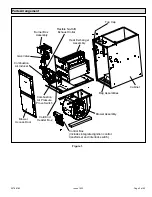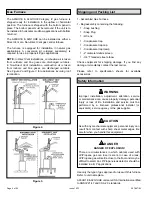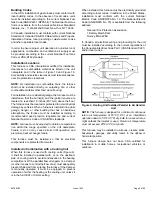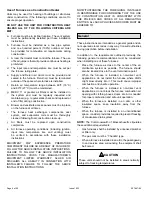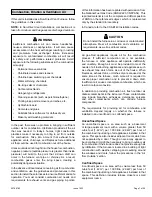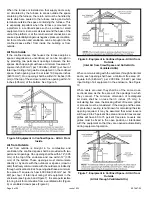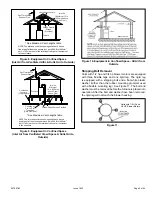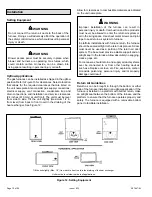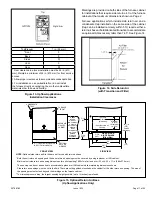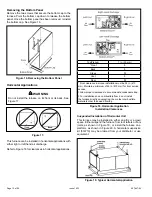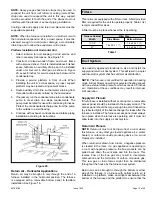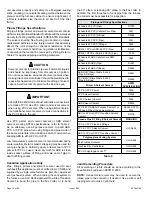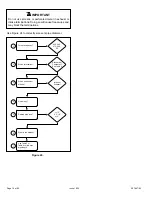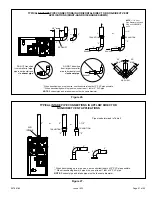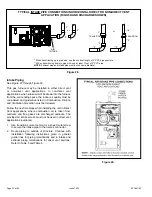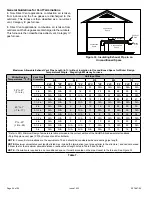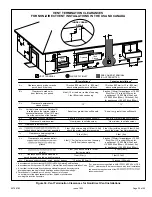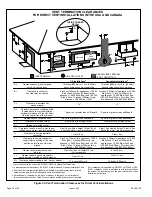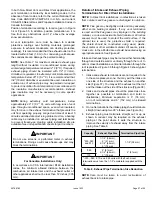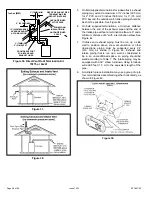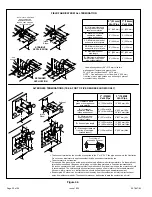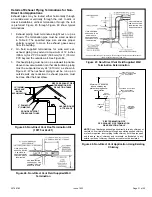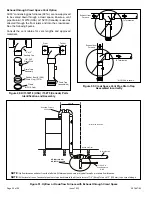
507867-02
Page 17 of 55
Issue 1933
6. After determining that each appliance connected to
the common venting system is venting properly, (step
3) return all doors, windows, exhaust fans, fireplace
dampers, and any other gas burning appliances to
their previous mode of operation.
7. If a venting problem is found during any of the
preceding tests, the common venting system must be
modified to correct the problems.
Resize the common venting system to the minimum vent
pipe size determined by using the appropriate tables in
Appendix G. (These are in the current standards of the
National Fuel Gas Code ANSI Z223.1.
Exhaust Piping
See Figure 25 and Figure 26
1. In areas where piping penetrates joist or interior walls,
hole must be large enough to allow clearance on all
sides of pipe through center of hole using a hanger.
2. When furnace is installed in a residence where unit
is shut down for an extended period of time, such
as a vacation home, make provisions for draining
condensate collection from trap and lines.
3. Route piping to outside of structure. Continue with
installation following instructions given in piping
termination section.
Do not discharge exhaust into an existing stack or
stack that also serves another gas appliance. If vertical
discharge through an existing unused stack is required,
insert PVC pipe inside the stack until the end is even
with the top or outlet end of the metal stack.
CAUTION
The exhaust vent pipe operates under positive pressure
and must be completely sealed to prevent leakage of
combustion products into the living space.
CAUTION
Vent Piping Guidelines
This gas furnace can be installed as either a Non-Direct
Vent or a Direct Vent gas central furnace.
NOTE:
In non-Direct Vent installations, combustion air is
taken from indoors and flue gases are discharged outdoors.
In Direct Vent installations, combustion air is taken from
outdoors and flue gases are discharged outdoors.
Intake and exhaust pipe sizing - Size pipe according to
Table 4 and Table 5 through Table 6. Table 4 lists the
minimum vent pipe lengths permitted. Table 5 and Table
6 list the maximum pipe lengths permitted for A93UH1E &
92G1UHE.
Regardless of the diameter of pipe used, the standard roof
and wall terminations described in section Exhaust Piping
Terminations should be used. Exhaust vent termination
pipe is sized to optimize the velocity of the exhaust gas as
it exits the termination. Refer to Table 8.
In some applications which permit the use of several
different sizes of vent pipe, a combination vent pipe may
be used. Contact Allied Air Technical Service for assistance
in sizing vent pipe in these applications.
Figure 23.
NOTE:
It is acceptable to use any pipe size which fits
within the guidelines allowed in Table 5 and Table 6.
NOTE:
The exhaust collar on all models is sized to
accommodate 2” Schedule 40 vent pipe. In horizontal
applications, transition to exhaust pipe larger than 2” must
be made in vertical runs of the pipe. A 2” elbow must be
added before the pipe is transitioned to any size larger
than 2”. This elbow must be added to the elbow count
used to determine acceptable vent lengths. Contact the
Application Department for more information concerning
sizing of vent systems which include multiple pipe sizes.
Capacity
Min. Vent Length*
030, 045, 070, 090, 110
15 ft. or
5 ft plus 2 elbows or
10 ft plus 1 elbow
* Any approved termination may be added to the minimum
length listed.
** This gas furnace must have 3” to 2” reducing elbow
(supplied or field replacement Canadian kit) installed directly
into unit flue collar.
Table 4. Minimum Vent Pipe Lengths

